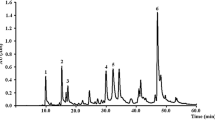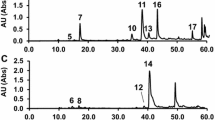Abstract
Chestnut inner skin was known to contain various phenolics as a potential antioxidant, and 3 phenolics (catechin, epicatechin, and gallic acid) were isolated. The relative antioxidant capacity of 3 phenolics in vitamin C equivalent antioxidant capacity (VCEAC) evaluated by ABTS assay was in decreasing order as follows: gallic acid>catechin>epicatechin>vitamin C. Gallic acid showed the highest inhibitory effect against acetylcholinesterase (AChE) in a dose-dependent manner and competitive inhibition. However catechins presented neuroprotective effects on amyloid β-induced neurotoxicity by MTT, lactate dehydrogenase (LDH) release, and neutral red uptake assays. Considering above data, it was supposed that gallic acid, catechin, and epicatechin have various antiamnesic effect in neurodegenerative diseases such as Alzheimer’s disease (AD). Therefore, it was strongly suggested that chestnut inner skin as phenolics-rich substance can be used in functional food supplement or pharmaceutical industry by utilization of wastage from valuable resources.
Similar content being viewed by others
References
Pappolla MA, Chyan YJ, Omar RA, Hsiao K, Perry G, Smith MA, Bozner P. Evidence of oxidative stress and in vivo neurotoxicity of β-amyloid in a transgenic mouse model of Alzheimer’s disease: A chronic oxidative paradigm for testing anti-oxidant therapies in vivo. Am. J. Pathol. 152: 871–877 (1998)
Hertel C, Hauser N, Schubenel R, Seilheimer B, Kemp JA. β-Amyloid-induced cell toxicity: Enhancement of 3-(4,5)-dimethylthiazol-2-yl)-2,5-diphenyltetrazolium bromide dependent cell death. J. Neurochem. 67: 272–276 (1996)
Marcus DL, Thomas C, Rodriguez C, Simberkoff K, Tsai JS, Strafaci JA, Freedman ML. Increased peroxidation and reduced antioxidant enzyme activity in Alzheimer’s disease. Exp. Neurol. 150: 40–44 (1998)
Runyons CR, Schmitt FA, Caban-Holt A, Kryscio RJ, Mendiondo MS, Markesbery WR. Antioxidants for the prevention of dementia: Overview of the pre-advise trial. Alzheimers Dement. 1: S74 (2005)
Shen Y, Sheng R, Zhang J, He Q, Yang B, Hu Y. 2-Phenoxy-indan-1-one derivatives as acetylcholinesterase inhibitors: A study on the importance of modifications at the side chain on the activity. Bioorg. Med. Chem. 15: 7646–7653 (2008)
Papandreou MA, Dimakopoulou A, Linardaki ZI, Cordopatis P, Klimis-Zacas D, Margarity M, Lamari FN. Effect of a polyphenolrich wild blueberry extract on cognitive performance of mice, brain antioxidant markers, and acetylcholinesterase activity. Behav. Brain Res. 198: 352–358 (2009)
Kim DO, Lee KW, Lee HJ, Lee CY. Vitamin C equivalent antioxidant capacity of phenolic phytochemicals. J. Agr. Food Chem. 50: 3713–3717 (2002)
Sreenivasulu K, Raghu P, Nair KM. Polyphenol-rich beverages enhance zinc uptake and metallothionein expression in Caco-2 cells. J. Food Sci. 75: H123–H128 (2010)
Heo HJ, Kim D-O, Choi SJ, Shin DH, Lee CY. Potent inhibitory effect of flavonoids in Scutellaria baicalensis on amyloid β proteininduced neurotoxicity. J. Agr. Food Chem. 52: 4128–4132 (2004)
Borges O, Carvalho J, Correia P, Silva AP. Lipid and fatty acid profiles of Castanea sativa Mill. chestnuts of 17 native Portuguese cultivars. J. Food Compos. Anal. 20: 80–89 (2007)
Vaughan JG, Geissler CA. The New Oxford Book of Food Plants. Oxford University Press, New York, NY, USA. pp. 34–38 (1997)
Barreira JCM, Ferreira ICFR, Oliveira MBPP, Pereira JA. Antioxidant activities of the extracts from chestnut flower, leaf, skins, and fruit. Food Chem. 107: 1106–1113 (2008)
Jeong CH, Choi GN, Kim JH, Kwak JH, Choi SG, Heo HJ. Characterization of antioxidant activities from chestnut inner skin extracts. Food Sci. Biotechnol. 18: 1218–1223 (2009)
Borenfreund E, Puerner J. Toxicity determined in vitro by morphological alterations and neutral red absorption. Toxicol. Lett. 24: 119–124 (1985)
Ellman GL, Courtney KD, Andres V Jr, Featherstone RM. A new and rapid colorimetric determination of acetylcholinestrase activity. Biochem. Pharmacol. 7: 88–95 (1961)
Chung YK, Heo HJ, Kim EK, Kim HK, Huh TL, Lim YH, Kim SK, Shin DH. Inhibitory effect of ursolic acid purified from Origanum majorana L. on the acetylcholinesterase. Mol. Cell 11: 137–143 (2001)
Ames BN, Shigenaga MK, Hagen TM. Oxidants, antioxidants, and the degenerative diseases of aging. P. Natl. Acad. Sci. USA 90: 7915–7922 (1993)
Klegeris A, McGeer PL. β-Amyloid protein enhances macrophage production of oxygen free radicals and glutamate. J. Neurosci. Res. 49: 229–235 (1997)
Jang JH, Surh YJ. Protective effect of resveratrol on β-amyloidinduced oxidative PC12 cell death. Free Radical Bio. Med. 34: 1100–1110 (2003)
Heo HJ, Choi SJ, Choi SG, Shin DH, Lee JM, Lee CY. Effects of banana, orange, and apple on oxidative stress-induced neurotoxicity in PC12 cells. J. Food Sci. 73: H28–H32 (2008)
Prasad MR, Lvell MA, Yatin M, Dhillon HS, Markesbery WR. Regional membrane phospholipid alteration in Alzheimer’s disease. Neurochem. Res. 23: 81–88 (1998)
Zhu JT, Choi RC, Chu GK, Cheung AW, Gao QT, Li J, Jiang ZY, Dong TT, Tsim KW. Flavonoids possess neuroprotective effects on cultured pheochromocytoma PC12 cells: A comparison of different flavonoids in activating estrogenic effect and in preventing β-amyloid-induced cell death. J. Agr. Food Chem. 55: 2438–2445 (2007)
Arts IC, Hollman PC, Feskens EJ, Bueno de Mesquita HB, Kromhout D. Catechin intake and associated dietary and lifestyle factors in a representative sample of Dutch men and women. Eur. J. Clin. Nutr. 55: 76–81 (2001)
Heo HJ, Lee CY. Epicatechin and catechin in cocoa inhibit amyloid β protein induced apoptosis. J. Agr. Food Chem. 53: 1445–1448 (2005)
Rein D, Lotito S, Holt RR, Keen CL, Schmitz HH, Fraga CG. Epicatechin in human plasma: In vivo determination and effect of chocolate consumption on plasma antioxidant status. J. Nutr. 130: 2109–2114 (2000)
Giacobini E. Cholinesterases: New roles in brain function and in Alzheimer’s disease. Neurochem. Res. 28: 515–522 (2003)
Khan MT, Orhan I, Senol FS, Kartal M, Sener B, Dvorská M, Smejkal K, Slapetová T. Cholinesterase inhibitory activities of some flavonoid derivatives and chosen xanthone and their molecular docking studies. Chem. Biol. Interact. 181: 383–389 (2009)
Mukherjee PK, Kumar V, Mal M, Houghton PJ. Acetylcholinesterase inhibitors from plants. Phytomedicine 14: 289–300 (2007)
Kang HS, Kim HR, Byun DS, Park KJ, Choi JS. Rosmarinic acid as a tyrosinase inhibitors from Salvia miltiorrhiza. Nat. Prod. Sci. 10: 80–84 (2004)
Youdim KA, Qaiser MZ, Begley DJ, Rice-Evans CA, Abbott NJ. Flavonoid permeability across an in situ model of the blood-brain barrier. Free Radical Bio. Med. 36: 592–604 (2004)
Author information
Authors and Affiliations
Corresponding author
Rights and permissions
About this article
Cite this article
Kim, J.H., Choi, G.N., Kwak, J.H. et al. Neuronal cell protection and acetylcholinesterase inhibitory effect of the phenolics in chestnut inner skin. Food Sci Biotechnol 20, 311–318 (2011). https://doi.org/10.1007/s10068-011-0044-3
Received:
Revised:
Accepted:
Published:
Issue Date:
DOI: https://doi.org/10.1007/s10068-011-0044-3




